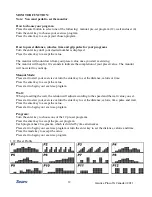
M
aurice Pincoffs Canada © 2011
20
Specificity
Different forms of exercise produce different results. The type of exercise that is carried out is specific
both to the muscle groups being used and to the energy source involved.
There is little transfer of the effects of exercise, i.e. from strength training to cardiovascular fitness.
That is why it is important to have an exercise program tailored to your specific needs.
Reversibility
If you stop exercising or do not do your program often enough, you will lose the benefits you have
gained. Regular workouts are the key to success.
Warm Up
Every exercise program should start with a
warm
up
where the body is prepared for the effort to
come. It should be gentle and preferably use the muscles to be involved later.
Stretching should be included in both your
warm up
and
cool down
, and should be performed after
3-5 minutes of low intensity aerobic activity or callisthenic type exercise.
Warm Down or Cool Down
This involves a gradual decrease in the intensity of the exercise session. Following exercise, a large
supply of blood remains in the working muscles. If it is not returned promptly o the central
circulation, pooling of blood may occur in the muscles
Heart Rate
As you exercise, so the rate at which your heart beat also increases. This is often used as a measure of
the required intensity of exercise. You need to exercise hard enough to condition your circulatory
system, and increase your pulse rate, but not enough to strain your heart.
Your initial level of fitness is important in developing an exercise program for you. If you are starting
off, you can get a good training effect with a heart rate of 110-120 beats per minute(BPM). If you are
fitter, you will need a higher threshold of stimulation.
To begin with, you should exercise at a level that elevates your heart rate to about 65 to 70% of your
maximum. If you find this is too easy, you may want to increase it, but it is better to lean on the
conservative side.
As a rule of thumb, the maximum heart rate is 220 minus your age. As you increase in age, so your
heart, like other muscles, loses some of its efficiency. Some of its natural loss is won back as fitness
improves.
The following table is a guide to those who are “starting fitness”.
Age
25
30
35
40
45
50
55
60
65
Target heart Rate
10 Second Count
23
22
22
21
20
19
19
18
18
Beats per Minute
138
132
132
126
120
114
114
108
108
Pulse Count
The pulse count(on your wrist or carotid artery in the neck, taken with two index fingers)is done for
ten seconds, taken a few seconds after you stop exercising. This is for two reasons: (a) 10 seconds is
long enough for accuracy, (b) the pulse count is to approximate your BPM rate at the time you are
exercising. Since heart rate slows as you recover, a longer count isn’t as accurate.
The target is not a magic number, but a general guide. If you’re above average fitness, you may work
quite comfortably a little above that suggested for your age group.
The following table is a guide to those who are keeping fit. Here we are working at about 80% of
maximum.
Age
25
30
35
40
45
50
55
60
65
Target heart Rate
10 Second Count
26
26
25
24
23
22
22
21
20
Beats per Minute
156
156
150
144
138
132
132
126
120
Содержание 16216685
Страница 15: ...Maurice Pincoffs Canada 2011 14 Diagram...







































